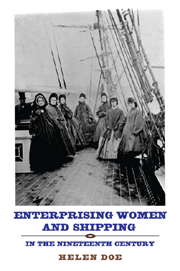Book contents
- Frontmatter
- Contents
- List of Tables and Figures
- List of Illustrations
- Dedication
- Acknowledgements
- Abbreviations
- Introduction
- 1 The Legal, Financial and Cultural Environment
- 2 Maritime Communities
- 3 Five Investor Ports
- 4 Shipowning Wives, Widows and Spinsters
- 5 Active and Passive Female Shipowners
- 6 Managing Owners
- 7 Port Businesswomen
- 8 Warship Builders
- 9 Merchant Shipbuilders
- 10 Conclusion: ‘A Respectable and Desirable Thing’
- Appendices
10 - Conclusion: ‘A Respectable and Desirable Thing’
Published online by Cambridge University Press: 12 September 2012
- Frontmatter
- Contents
- List of Tables and Figures
- List of Illustrations
- Dedication
- Acknowledgements
- Abbreviations
- Introduction
- 1 The Legal, Financial and Cultural Environment
- 2 Maritime Communities
- 3 Five Investor Ports
- 4 Shipowning Wives, Widows and Spinsters
- 5 Active and Passive Female Shipowners
- 6 Managing Owners
- 7 Port Businesswomen
- 8 Warship Builders
- 9 Merchant Shipbuilders
- 10 Conclusion: ‘A Respectable and Desirable Thing’
- Appendices
Summary
In 1865 Bessie Parkes wanted women to be able to practise a profession or run a business and for this to become ‘a respectable and desirable thing’. The locally owned wooden sailing vessel gave women that opportunity. This was the heyday of the merchant sailing vessel and since most were owned under the 64th system, this was also the time of the fractional shipowner. In 1871 the number of sailing vessels registered in England and Wales was 17,606 and the number of steamships was just 2,557. The gap between London and Liverpool, with a total of 2,829 vessels and 2,499 vessels respectively, and the next largest port, Rochester, with 807 vessels, was significant. Sixty-nine per cent (fifty-eight out of eighty-four) of the ports had up to 200 vessels on their register and 70 per cent of ports had less than 20,000 tons registered. In these ports around England, women were shipowners; they managed men, dealt with customers, handled the logistics of complex businesses and were not limited to ‘feminine’ trades.
A new view of the nineteenth-century middle-class woman is beginning to emerge. Historians have been challenging the separate spheres theory in studies of businesswomen in Birmingham and London. Most recently the investments of the nineteenth-century woman have been scrutinised in a series of articles, all of which are developing themes of independent activity.
- Type
- Chapter
- Information
- Enterprising Women and Shipping in the Nineteenth Century , pp. 216 - 224Publisher: Boydell & BrewerPrint publication year: 2009



